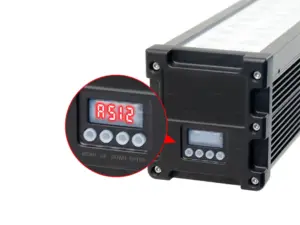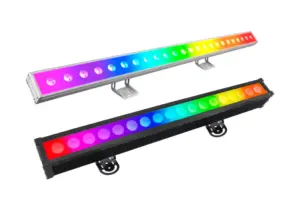LED wall washer lights transform ordinary spaces into stunning visual displays. They create smooth, even illumination that flows across walls and surfaces. Their illumination adds depth to rooms and adds drama to building exteriors.
Many people use LED wall washer lights outdoors and within their homes. This guide will explain everything about installing, using, and selecting LED wall washer lights.
What are LED Wall Washer Lights?
These are a specific type of lighting devices that casts uniform light on vertical surfaces. Unlike spotlights, which create focused beams, LED wall washers spread lights evenly. They “wash” wall surfaces and eliminate shadows to highlight wall sections.

Since they use LED technology, these lights are energy efficient and last longer than traditional lights. Most LED wall washer lights work up to 50,000 hours (nearly six years of continued use). Compared to halogen alternatives, they generate minimal heat.
The light output also stays consistent throughout their lifespan. Advanced models offer RGB color mixing and smart controls. Most units require minimal upkeep beyond basic cleaning.
Steps and Tips for Installing LED Wall Washer Lights
1. Measurements and Spacing
Good installation creates the best lighting effect. Start by measuring your walls and then count how many fixtures you need. Next, mark where each light will go and check your electrical system’s capacity. You’ll need to make sure your mounting surface can hold your lights.
After measuring and marking your wall, check to see that the marks you made are properly spaced. Proper spacing makes light look even, so keep the lights a few inches from the wall. The distance should be 12 to 24 inches. Next, you should space the fixtures evenly by allowing 24 to 36 inches between each one. This spacing prevents hot spots and ensures uniform coverage. Make sure you test the positions before the final mounting.
Your mounting height affects the light coverage. Eight-foot walls, for instance, need lights mounted 6 to 7 feet high. Ten-foot walls need them 8 to 9 feet high, while taller walls might need several rows of light.
2. Wiring and Power
Safe electrical work is an important part of the installation process. Check your total power needs and if your circuits can handle the load.
Use the right wire size specified in your instruction manual and install protection against power surges. Consider including backup power as an added safety net.
Modern wall washers offer many control options. Simple switches work for basic setups, while dimmers add flexibility. Some lights also change colors, and others are connected to home automation. Therefore, pick controls that match your needs.
3. Control Systems
Modern wall washer lights offer various control methods. For simple setups, a basic switch will suffice. Basic units include manual dimming switches. Advanced models feature DMX protocol integration. This allows precise control over brightness and color.

Smart control systems enhance functionality. WIFI-enabled fixtures connect to home automation platforms. Mobile apps provide convenient adjustment options. Programmable schedules automate operations based on the time of day.
Some systems also include motion sensors and photocells. These automatically adjust output based on ambient light or occupancy. Such features improve energy efficiency while maintaining desired lighting levels.
4. Outdoor Installation Tips
For outdoor installations, you need to take extra precautions. Seal all your connections to protect them from moisture. You can also use waterproof junction boxes and run conduits for wire protection. If you have ground fixtures installed, consider digging drainage systems around them.
Weather plays a vital role in the performance of your lights. If possible, always try to place your lights under eaves or shades. Rubber gaskets can protect against the elements for better sealing. Another tip is to point the lights downwards to drain and prevent water from pooling after rain.
5. Maintenance and Care
Regular care will keep your light in working condition throughout its lifespan. You can start with simple maintenance practices like cleaning the lenses monthly with a soft cloth and checking the connections every three months. Ensure your investigation is thorough to identify loose parts or connections early on. If you notice any failed units, replace them immediately. This is why you should always have spare parts ready in cases of emergency.
In addition, you should watch out for common problems like dim lights and flickering. Dim lights could mean your fixture needs cleaning, and flickering may indicate a loose wire connection somewhere. Other issues like color changes might suggest unit failure, while strange noises could signify loose parts.
How To Choose The Right Wall Washer Light?

Your selection depends on the installation space and desired light intensity. Residential spaces typically need fixtures producing 1,000 to 2,000 lumens. Commercial areas demand higher output levels. Retail stores and galleries often require 3,000 to 5,000 lumens for proper illumination.
Before buying a wall washer light, first measure your wall. Then, check the light manufacturer’s recommendations for coverage. If you want more expert help, you could also invite a professional.
Color temperature impacts the atmosphere of your space. They contribute to the appeal and aesthetic of your living or work areas. For example, warm lights create a cozy environment perfect for home settings. Cool white lights, on the other hand, are best used in display areas like art galleries. They provide more clarity and make the display pieces pop.
Another factor to consider before purchasing is the protection ratings which affect durability. Indoor lights need basic protection while covered outdoor areas need more weather resistance. Exposed outdoor lights need the highest protection. Therefore, if your lights are for full outdoor use, look for those with IP65 or IP66 ratings.
The beam angle changes how light spreads. Narrow angles (15 to 30 degrees) work for accent lighting. Medium angles (40 to 60 degrees) suit standard wall washing. And wide angles (90 to 120 degrees) cover large surfaces. Therefore, you should pick a wall washer light with a beam angle relative to your wall size.
